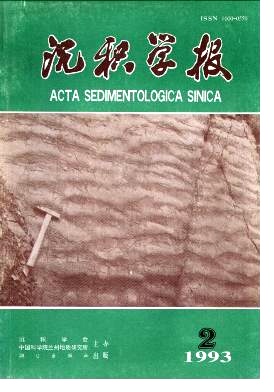Sequence Structural Characteristics of the Devonian Volcanoclastic Turbidites in Northern Xinjiang and Their Geological Significance
- Received Date: 1991-06-19
- Publish Date: 1993-06-10
Abstract: The volcaniclastic turbidites which are characterized by more than 25% pyroclastic contents and by the Bouma sequence are widely distributed in the Upper Devonian of east Jung-gar, the lower part of the Lower Devonian and the Upper Devonian of west Junggar. In terms of grainsize, they are subdivided into coarse, medium and fine grained volcaniclastic turbidite facies. Twenty sequence structures are recognized, which may be merged in three types; the completed, the continued-uncompleted and the punctuated-uncompleted Bouma sequence, i. e., Tabcde; Tabc or Tab; Tae, Tad or Tabe. Statistical data indicates that the sequence structures of the volcaniclastic turbidites in Northern Xinjiang are dominated by the punctuated-uncompleted Bouma sequences, the thickness frequences are 57. 6%, 73. 3% and 78. 9% respectly in the Zhifang section of east Junggar, the Heishantou section and the Sarburtishan section of west Junggar. The above gradual increasing of frequences corresponds to the strengthening of volcanic, seismic and tectonic activities and to the increasing of distal and fine grained volcaniclastic turbidites in the above sections. The punctuated-uncompleted Bouma sequences of the volcaniclastic turbidites would be formed in the mutual interference of several turbidity current events of in the mutual interference of turbidity current event (s) and other events (volcanic, seismic and tsunami events etc. ). A turbidity current sedimentation would be easily affected by other geologic processes in distal and fine grained turbidite region where a turbidity current energy is lower. In volcanic island are environments, frequent volcanic and seismic events affect easily a turbidity current sedimentation. Therefore, a punctuated-uncompleted sequence of turbidites would be one of the diagnostic indicators of distal and fine grained turbidites, and the turbidity current sedimentation region of polydirections and polyresources and an active tectonic setting.
| Citation: | Gong Yiming. Sequence Structural Characteristics of the Devonian Volcanoclastic Turbidites in Northern Xinjiang and Their Geological Significance[J]. Acta Sedimentologica Sinica, 1993, 11(2): 75-83. |






 DownLoad:
DownLoad: